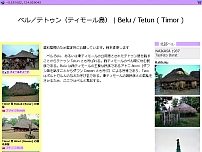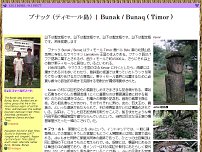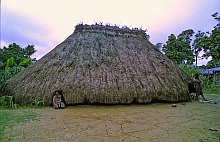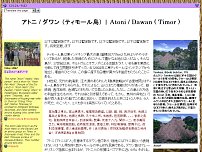ファタルク(東ティモール) | Fataluku (Timor Leste)
本ページはデータ整理のために製作&公開しています。
1975年ポルトガルからの独立後、インドネシアに併合されたものの内乱はおさまらず、インドネシア統治下の東ティモール Timor Timur(通称TimTim)は外国人の訪問をかたく禁じられてきた。そんななか、私がはじめてこの地訪れたのは1986年、キサール島からの帰路、乗りあわせた帆船の目的地がディリだったためだ。それもたった一日の滞在を許されただけで、翌日には西ティモールのクパンに向かうバスに乗らされていた(この経緯については フィールドノート1986  を見てください)。
を見てください)。
東ティモールといえば、「ロスパロスの民家」がつとに有名で、ガイドブックを飾るその勇姿を一度は見ておきたいとひそかに念じていた。が、ロスパロスはディリのはるか250kmも東、この時も思いは果たせず、東ティモールに従軍した兵士の土産品だろうか、1メートルも高さのある白檀製の民家模型を購入できたのが唯一の成果だった。
時はめぐり、2002年に東ティモールが独立を果たしてからもなかなか調査の機会は訪れなかった。最初の訪問から30年以上たった2018年10月、ついに私はディリを再訪した。観光客向けの物価は異常に高く、国中どこもかしこも道路は工事で寸断されている。やむなく高価な四駆の車をチャーターしてわずか一週間ほどで島をめぐる。もはやインドネシア語も満足に通じるとはいえない。とても調査とはいえない旅程の備忘録として本ページを作成する。
西ティモールのアトニ族のもとに儀礼家屋 Ume Leu(Dawan語)があったのと同様、東ティモールでも一般に Uma Lulik(Tetum語の「神聖な家」)、Lee Teinu(Fataluku)、Uma Luli(Naueti)、Oma Bese(Makasae)などと呼ばれる建築がある。神聖な器物を保管し、特別な儀礼をおこなう。いわば親族や社会の統合の象徴であり、その特異な建築形態は民族的アイデンティティの源泉ともなっている。
FATALUKU

ファタルクは東ティモールの東のはて、ラウテン Lauten 県の首都ロスパロス Lospalos 周辺に住む民族。非オーストロネシア語族だが、典型的な穀倉型家屋をもつ。極端に棟のあがった独特の建築様式は東ティモールのシンボルとして脚光をあびることが多かった~写真は古い絵葉書より
Lospalos 2018
Lospalos, Suco Fuiloro 
町の中心、文化センターの広場に建つ儀礼家屋 Lee Teinu。(7氏族?の中心家屋として?)1994年に建設された。一家族が住んでいたが、2018年時点ではすでに住人なく倒壊がはじまっている。屋根は fia (tua marau の樹皮の繊維、マレー語のいわゆるijuk)で葺く。




Luarai, Suco Bauro 
有名な連棟の Lee Teinu だったが、2018年、すでに西棟は倒壊、東棟も悲惨な状態になっていた。




Iralafai, Suco Bauro 
規模は小さいが伝統形式の家屋が多く残る。平面の構成は方位に従い、炉は Tahi Tupuru(女の海=北)に、入口は Tahi Calu(男の海=南)に配置する。初柱 Tutu Kaka は Moa Cau(太陽が昇る)側にある。









Moulo'o, Suco Raça 
1996年建設の Lee Teinu がある。屋内には Tahi Tupuru(女の海=北)によせて二つの炉があり、Wacu Hiamoinu(太陽昇る=東)の炉は初柱 Tutu Kaka の真上にある儀礼用、Watu Isinu(太陽沈む=西)の炉は普段用。入口は Tahi Nami(男の海=南)の西側床下にあく。






Lautém 2018
Laicara, Suco Maina II 
Lee Teinu が二棟ある。2004年建設の Lee Teinu





1991年建設の Lee Teinu。



 屋内南面。左より入口 O'o、食器、食物を置く棚 Rau Ariwana、普段の炉 Asa
屋内南面。左より入口 O'o、食器、食物を置く棚 Rau Ariwana、普段の炉 Asa
 屋内西面
屋内西面
 屋内北面。左より儀礼用の炉 Asa Kaka、寝所 Aliwana、炉 Asa
屋内北面。左より儀礼用の炉 Asa Kaka、寝所 Aliwana、炉 Asa 屋内東面
屋内東面
MAKASAI
Laga 2018
Baukau県北東部の地区Utufalu







TETUN
Balique 2018
Manatuto県南部の地区AimetaLaran,
Suco SikoneDiloli
2017年に Suco UmaBoku より分離した新Sucoで、Tetun Terik(Tetun語の東部方言)の文化圏にある




Suai 2018
Cova Lima 県西部の海岸地帯の地区。インドネシア、ベル地域のTetunは東ティモールからの移民も多い。家屋もよく似る ベル ( ティモール島 ) | Belu ( Timor )
ベル ( ティモール島 ) | Belu ( Timor )
Mane Icun,
Suco Suai Loro 





神聖な家 Uma Lulik



Uma Lulik の建設。部外者が近寄ることはできない










Salelebo' ??




BUNAK
東ティモールのBunakはインドネシアからの移民が多いようだ ブナック ( ティモール島 ) | Bunak ( Timor )
ブナック ( ティモール島 ) | Bunak ( Timor )
Suai 2018
Dais, Suco Labarai 




Salelebo' ??
Tetun人集落のなかの移民家族




Bobonaro 2018
???, Suco Malilait
家主自慢の建築。部材も彫刻も現代建築だが、海の柱、火の柱をそなえた立派な慣習家屋






MAROBO
BOBONARO県中部の山地民。文化的に Ema / Kemak とされることもある。Bobonaro 2018
Atuabe 
かつての集落は山頂ちかくにあった。巨石文化の面影がのこる旧村






旧村はすでに放棄され、現在は車道に沿って散居している。2009年に建設された慣習家屋












Marobo 2018
東ティモールの行政区分
全国は13の県(municipality、旧 district)に分かれる。
県は65の地区(administrative post、旧 sub-district)に分かれ、
地区の下に442の村(suco)、村の下に2336の部落(aldeias)がある。
Fataluku (also known as Dagaga, Dagoda', Dagada) is a non-Austronesian language spoken by approximately 37,000 people of Fataluku ethnicity in the eastern areas of East Timor, especially around Lospalos. It is a member of the Timor-Alor-Pantar language family. Fataluku's closest relative is Oirata,
spoken on Kisar island.
 Wikipedia
Wikipedia
The principal coordinate of orientation among Fataluku is ordered along the east-west axis. Typically this is expressed as an associated distinction between head and tail: mua cao, mua ulafuka ‘head of the land, tail of the land’. A second-order orientation is marked in relation to the seas to the north and south. The terms tahi tupurru—tahi calu (‘female’ sea—‘male’ sea) represent a composite linguistic construction of Austronesian and Papuan terms.


Timor 島 Kemak (Ema) の家屋

1986年当時Dilliで売られていたTimtim土産の白檀製家屋模型
東ティモールアクセス情報 2018年版

インドネシアからの空路はバリ発のみ。他にシンガポール便とダーウィン便がある

プレジデンテ・ニコラウ・ロバト国際空港 Aeroporto Internacional Presidente Nicolau Lobato 首都ディリまでは約15km。ニコラウ・ロバトの事跡についてはwikiでも調べてください

呑気に写真など撮っているから遅くなる、、、

空港で30USD払えば Arrival Visa を取得できるのだが窓口は大混乱、遅れてならんだ私はイミグレ通過までに50分ちかくも待たされる羽目になった

インドネシア側ビザ不要の帰路は陸路で国境越え。ディリ発クパン行きの小型バス(12人乗り)を各旅行会社が運行している。早朝7:30発、インドネシア領内で途中下車も可能。ディリ/アタンブアは15USD

国境のある Batugade まで2時間。バスを降り、軍によるパスポート・チェックをうける。バスは荷物共々国境の先で待っていてくれる

そのまま歩いて東ティモールのイミグレへ向かう

待つこともなくイミグレを通過して振りかえると

インドネシア側から入国するときはこんな景色

国境のある橋をわたる

インドネシア側のゲートを通ってイミグレへ

簡単に通過できると思いきや、
外国人と見てとると別室に連れ込まれ、 身分証をみせろからはじまって難癖質問攻め。。。
なぜ飛行機に乗らない?
アタンブアに行きたい?
目的はなんだ?
泊まるところはあるのか?
なぜホテルを予約しない?
電話がない?
ならここから電話しなさい
とまあ、ホテルの予約までさせられる始末。ありがた迷惑で、30分ほども拘束されることになりました。バスは先刻承知なのか、乗客のみなさんもおとなしく待っていてくれました
- CINATTI, Ruy "Tipos de Casas Timorenses e Um Rito de Consagracao", Actas Do Congresso Internacional de Etnografia, Promovido Pela Camara Municipal de Santo Tirso de 10 a 18 de Julho de 1963 Vol.4 Coloquio de Etnografia Comparada, pp.155-179, 1963
- CAMPAGNOLO, Maria Olimpia Lameiras "L'habitation des Fataluku de Lorehe (Timor Portugais)", These de Doctorat de 3eme Cycle, Universite de Paris 5 (Rene Descartes), 296P, 1975
- DUARTE, Jorge Barros "Casa Turi-Sai-Um: Tipo de Casa Timorense", Garcia de Orta,Serie de Antropologia 2-1/2, pp.1-33, 1975
- CLAMAGIRAND, Brigitte "La Maison Ema (Timor Portugais)", Asie du Sud-Est et Monde Insulindien 6-2/3, pp.35-60, 1975
- HICKS, David "Roh Orang Tetum di Timor Timur", Seri Budi 4, 147P [pp.66-74], Pustaka Sinar Harapan,1976
- CLAMAGIRAND, Brigitte "The Social Organization of the Ema of Timor", James J.FOX (ed.) "THE FLOW OF LIFE: ESSAYS ON EASTERN INDONESIA", Harvard University Press, Cambridge, pp.134-151, 1980
- CLAMAGIRAND, Brigitte "MAROBO, UNE SOCIÉTÉ EMA DE TIMOR CENTRAL", Langues Et Civilisations de L'Asie Du Sud-Est Et Du Monde In, 1982
- TRAUBE, Elizabeth G. "Cosmology and Social Life: Ritual Exchange among the Mambai of East Timor", University of Chicago Press, 289P [pp.66-80], 1986




 短期間の滞在記録ですから、本ページ中には多々間違いがあろうかと思われます。ご叱正いただければ誤った情報は改めていきます
短期間の滞在記録ですから、本ページ中には多々間違いがあろうかと思われます。ご叱正いただければ誤った情報は改めていきます